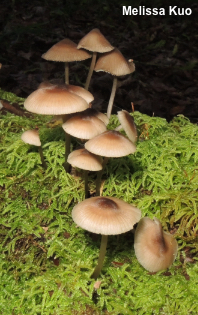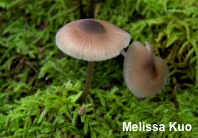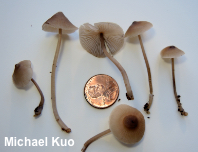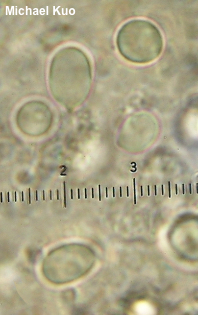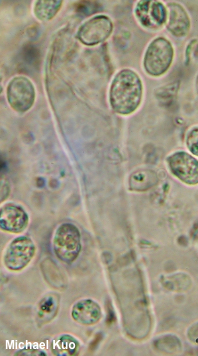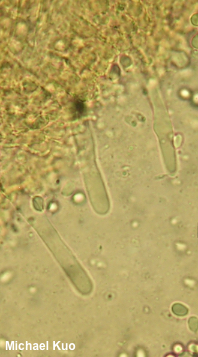| Major Groups > Gilled Mushrooms > Pale-Spored > Mycenoid Mushrooms > Mycena algeriensis |

|
[ Basidiomycota > Agaricales > Mycenaceae > Mycena . . . ] Mycena algeriensis by Michael Kuo, 24 November 2022 Found on well-decayed hardwood logs, Mycena algeriensis features a dark brown cap that fades somewhat with maturity, leaving a contrasting "eye" over the center. Its stem is brown all the way to the apex, it lacks a distinctive odor when the flesh is crushed, and its gills remain whitish throughout development. In other words, as is the case with many mycenoid mushrooms, the crucial identifying features of Mycena algeriensis are microscopic: look for the prominent pleurocystidia on the sides of the gills, and the smooth cheilocystidia on the edges of the gills, along with the medium-sized (for Mycena) amyloid spores and smooth pileipellis elements. Mycena algeriensis is a poorly known and poorly documented species, and it is unclear whether the North American and European mushrooms going under this name are actually the same as the originally described species, collected in Algeria on eucalyptus wood just a few years before Rommel's Panzers arrived. It's not even clear whether the European and North American versions of the species are the same, or the North American versions from across the continent. The world of mycology awaits an in-depth, contemporary study. I don't recommend you hold your breath in anticipation. Description: Ecology: Saprobic on well-decayed hardwood logs and stumps; growing gregariously or in loose to dense clusters; spring and fall; originally described from Algeria (Maire 1938); fairly widely distributed in Europe and in North America (but see comments above). The illustrated and described collection is from Kentucky. Cap: 1.5–3 cm across; at first conic; expanding to bell-shaped or convex, with a central bump; finely lined radially; bald; tacky when fresh; dark brown overall when young, and remaining so over the center, but elsewhere becoming medium grayish brown. Gills: Narrowly attached to the stem; close or nearly distant; white; not bruising or staining; short-gills frequent. Stem: 3–6 cm long; 2–3 mm thick; equal; hollow; when young with tiny, whitish, contrasting flecks, especially near the base—but soon bald; grayish brown; basal mycelium white. Flesh: Insubstantial; whitish; not changing when sliced. Odor and Taste: Odor not distinctive. Chemical Reactions: KOH negative on cap surface. Spore Print: White. Microscopic Features: Spores 7–10 x 5–6 µm; ellipsoid; smooth; hyaline in KOH; weakly to moderately amyloid. Hymenium pinkish in Melzer's reagent. Basidia 24–30 x 5–6 µm; clavate; 2- or 4-sterigmate. Pleurocystidia 60–70+ x 8–15 µm; lageniform or flexuous-cylindric; smooth; thin-walled; hyaline in KOH. Cheilocystidia 30–40 x 5–6 µm; flexuous-cylindric to subclavate; smooth; thin-walled; hyaline in KOH. Pileipellis an ixocutis of poorly defined, smooth, gelatinizing elements 1–2.5 µm wide; hyaline to yellow-brown in KOH. REFERENCES: R. C. J. E. Maire, 1938. (Smith, 1947; Kühner & Romagnesi, 1953; Moser, 1983; Aronsen, 2002; Robich, 2006; Emmett et al., 2018.) Herb. Kuo 10041509. This site contains no information about the edibility or toxicity of mushrooms. |
© MushroomExpert.Com |
|
Cite this page as: Kuo, M. (2022, November). Mycena algeriensis. Retrieved from the MushroomExpert.Com Web site: http://www.mushroomexpert.com/mycena_algeriensis.html |
